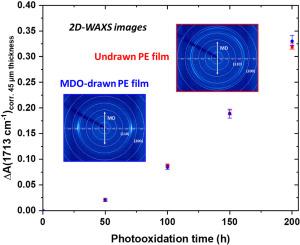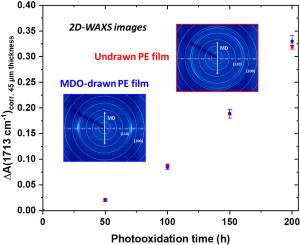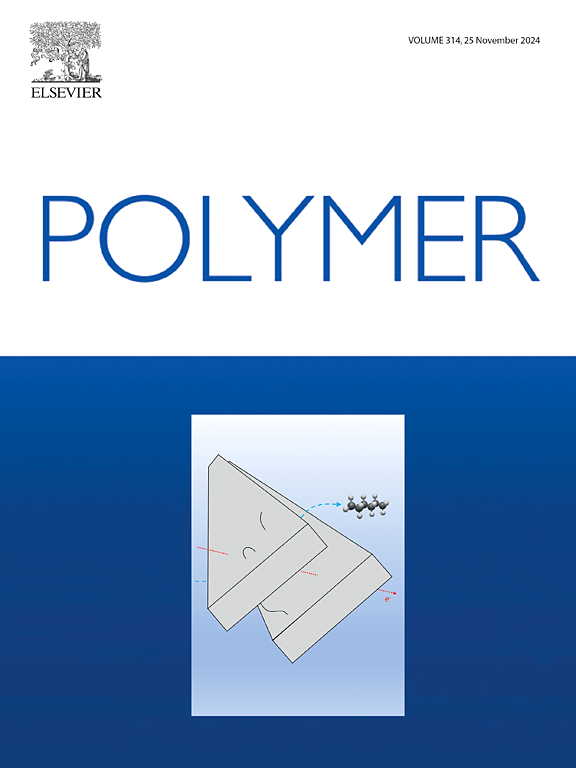机器定向拉伸聚乙烯薄膜的特性及其对光氧化的影响
IF 4.1
2区 化学
Q2 POLYMER SCIENCE
引用次数: 0
摘要
我们首先通过互补分析方法研究了机器定向(MDO)单轴拉伸对聚乙烯薄膜的影响。XRD 和偏振傅立叶变换红外光谱显示,聚乙烯的初始球状结构转变为由沿拉伸方向的无定形链连接的小晶块组成的微纤维。在 MDO 加工过程中没有观察到应力引起的结晶,但由于这种形态变化,氧气渗透率降低了 30%。第二次研究了光氧化对未拉伸薄膜和 MDO 拉伸薄膜的影响。它们之间的光氧化动力学和化学计量没有差异。在任何光氧化之前,都能观察到聚合物结构因物理老化而发生轻微重组,但在光化学老化后,取向没有发生变化。最后,未拉伸薄膜和 MDO 拉伸薄膜的透氧率由于光氧化引起的变化而下降,特别是在最初无极性的聚乙烯中形成极性官能团和发生化学结晶。本文章由计算机程序翻译,如有差异,请以英文原文为准。


Characterization of polyethylene films drawn by machine direction orientation and consequences on their photooxidation
The effect of uniaxial drawing by Machine Direction Orientation (MDO) on polyethylene films was first studied by complementary analytical methods. XRD and polarized FTIR spectroscopy revealed the transformation of the initial spherulitic structure of PE into microfibrils composed of small crystalline blocks connected by amorphous chains oriented along the drawing direction. No stress-induced crystallization was observed upon MDO processing, but the permeability to oxygen was reduced by 30 % owing to this morphology change. In a second time, the effect of photooxidation on undrawn and MDO-drawn films was studied. There was no difference in the photooxidation kinetics and stoichiometry between them. A slight reorganization of the polymer structure due to physical ageing was observed before any photooxidation, but no change in orientation occurred upon photochemical ageing. Finally, the oxygen permeability of undrawn and MDO-drawn films decreased owing to the changes brought by photooxidation, especially the formation of polar functions within the initially apolar polyethylene and the occurrence of chemicrystallization.
求助全文
通过发布文献求助,成功后即可免费获取论文全文。
去求助
来源期刊

Polymer
化学-高分子科学
CiteScore
7.90
自引率
8.70%
发文量
959
审稿时长
32 days
期刊介绍:
Polymer is an interdisciplinary journal dedicated to publishing innovative and significant advances in Polymer Physics, Chemistry and Technology. We welcome submissions on polymer hybrids, nanocomposites, characterisation and self-assembly. Polymer also publishes work on the technological application of polymers in energy and optoelectronics.
The main scope is covered but not limited to the following core areas:
Polymer Materials
Nanocomposites and hybrid nanomaterials
Polymer blends, films, fibres, networks and porous materials
Physical Characterization
Characterisation, modelling and simulation* of molecular and materials properties in bulk, solution, and thin films
Polymer Engineering
Advanced multiscale processing methods
Polymer Synthesis, Modification and Self-assembly
Including designer polymer architectures, mechanisms and kinetics, and supramolecular polymerization
Technological Applications
Polymers for energy generation and storage
Polymer membranes for separation technology
Polymers for opto- and microelectronics.
 求助内容:
求助内容: 应助结果提醒方式:
应助结果提醒方式:


